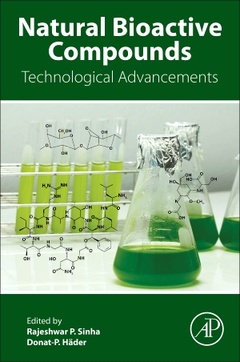Description
Natural Bioactive Compounds
Technological Advancements
Coordinators: Sinha Rajeshwar P., Häder h.c. Donat-P.
Language: English
Subject for Natural Bioactive Compounds:
Keywords
a-acids; ß-acids; Agar; Algae; Algin; Alginate; Antibiotics; Anticancer agents; Anticancerous agent; Antifouling; Antimalarial; Antioxidants; Antioxidats; Applications; Artemisinin; Bacteria; Bacterial cell wall; Beer industry; Bioactive compound; Bioactive compounds; Bioactive molecules; Bioactive peptides; Bioactive substances; Bioactivity; Bioreactor; Biosynthesis; Biotechnological application; Biotechnology; Bryophytes; Carotenoids; Carrageenan; Characterization; Chromatography; Cold-water corals; Commercialization; Constraints; Control of pathogenic bacteria; Conventional/classical extraction methodologies and nonconventional extraction technologies; Coral reefs; Corals; Cyanobacteria; Elicitation; Essential oils; Extraction; Extraction methodology; Fermentation; Fish; Fish protein hydrolysate; Flavanoids; Flavonoids; Fluorescence; Food additive; Food additives; Food production; Fragrances; Fungi; Gel; Gorgonians; Green algae; Green algal bloom; Higher plants; Hops; Hornworts; Hydrocolloid; Hydroxyapatite; Insect pest; Iso-a-acids; LC-PUFAs; Lichens; Lipids; Liverworts; Macroalgae; Mass cultivation; Metabolites; Microalgae; Microorganisms; Mode of action; Mollusks; Mosses; Mycosporine-like amino acids; n-3 fatty acid; Nanoparticles; Nanotechnology; Natural bioactive compounds; Natural bioactive compounds (NBCs); Nutraceuticals; Peptides; Pesticides; Phaeophyta; Pharmaceutical substances; Pharmaceuticals; Pharmaceutics; Phenolic compounds; Phenolics; Photoprotection; Pigments; Plant products; Plant secondary metabolites; Polyunsaturated fatty acids; Protein biosynthesis
502 p. · 19x23.3 cm · Paperback
Description
/li>Contents
/li>Readership
/li>Biography
/li>Comment
/li>
2. Bioactive compounds from bacteria and viruses
3. Advances in phycobiliproteins research: Innovations and commercialization
4. Cyanobacterial photoprotective compounds: Characterization and utilization in human welfare
5. Bionanotechnology of cyanobacterial bioactive compounds
6. Bioactive molecules from microalgae and constraints in commercialization
7. Strategies of overproduction of lipids and fine chemicals from commercially important microalgae
8. Biotechnological Exploitation of Macroalgae
9. Algal compounds to fight human diseases such as Alzheimer’s dementia and cancer
10. Bioactive compounds and their future therapeutic applications
11. Novel Biotechnological Substances from Bryophytes
12. Biotechnological Substances in Lichens
13. Bioactive Compounds in Fungi
14. Novel Biotechnological Substances in Higher Plants
15. New perspectives of the Artemisia annua bioactive compounds as an affordable cure in treatment of malaria and cancer
16. Pesticidal efficacy of plant bioactive compounds: An overview
17. Marine Sponges: Source of Novel Biotechnological Substances
18. Biotechnological Compounds from Corals
19. Bioactive Compounds from Fish
20. Advances in extraction technologies-Isolation and purification of bioactive compounds from biological materials
Researchers and students interested in bioactive natural products
Before his retirement, Prof. em. Dr. Dr. h.c. D-P. Häder has been a director of the Botanical Institute and held the chair of Ecophysiology of Plants at the Friedrich-Alexander University, Erlangen-Nürnberg, Germany, and was the director of the Botanical Garden. He is the author of more than 720 scientific publications, has produced 29 books, and holds 7 national and international patents. He is or has been editor of several international journals and is currently section editor of Environmental Toxicology in Frontiers in Environmental Sciences. His research interests are ecophysiology and ecotoxicology of aquatic ecosystems and is appointed member of the Environmental Effects Panel of the United Nations on the effects of ozone depletion and climate change.
- Explores natural sources of bioactive compounds, including cyanobacteria, bacteria, viruses, fungi and higher plants
- Discusses the potential applications of biological products, such as their use in medicine (antibiotics, cancer research, immunology), as food additives, supplements and technological substances
- Analyzes the contributions of emerging or developing technologies for the study of bioactive natural compounds (characterization and purification)




